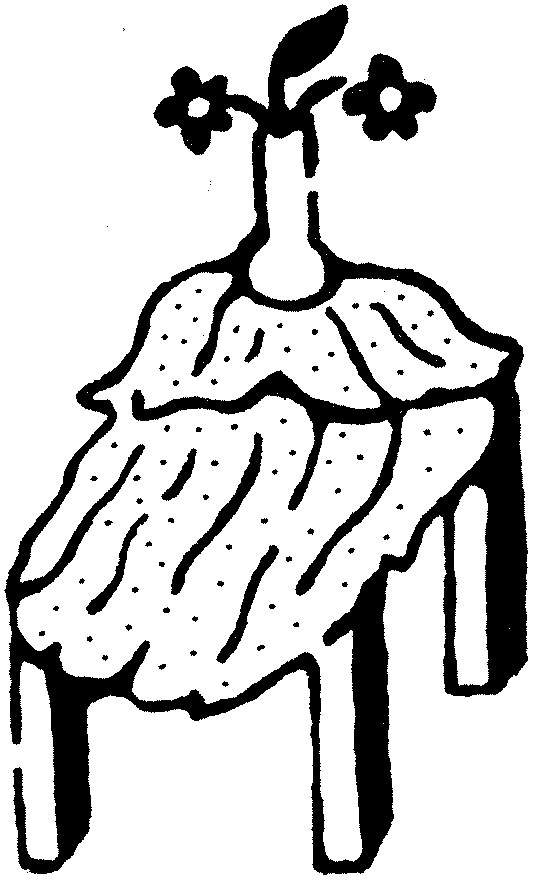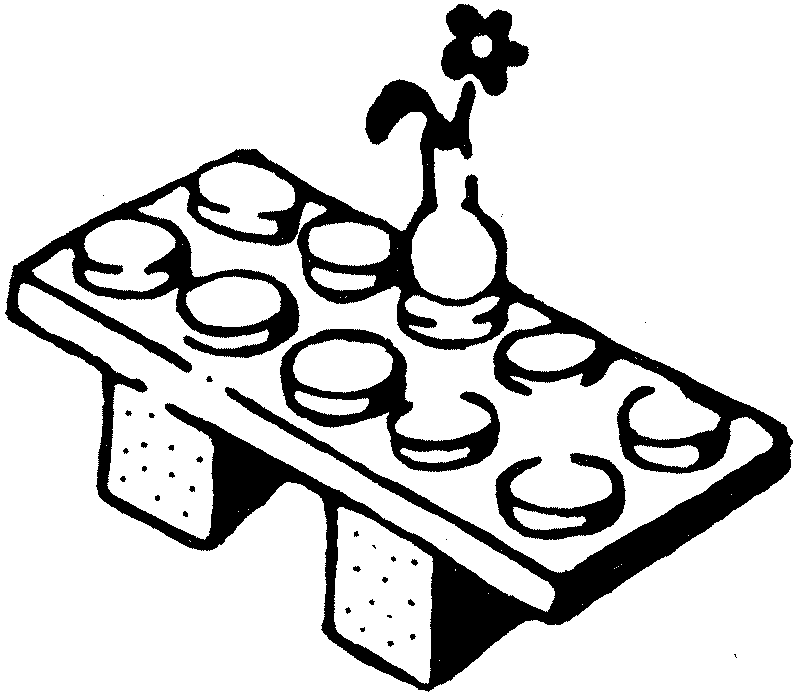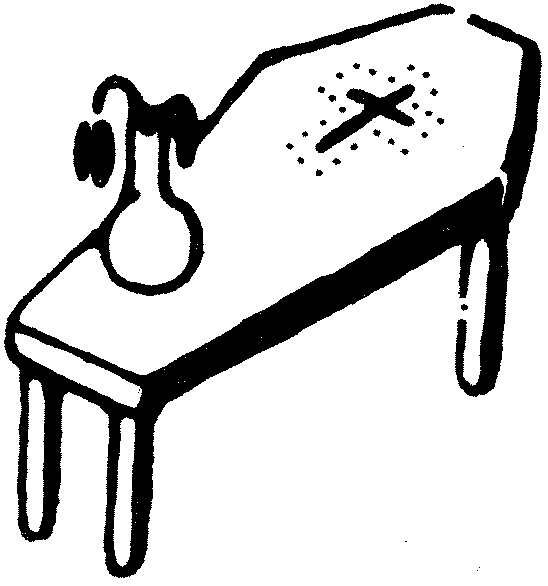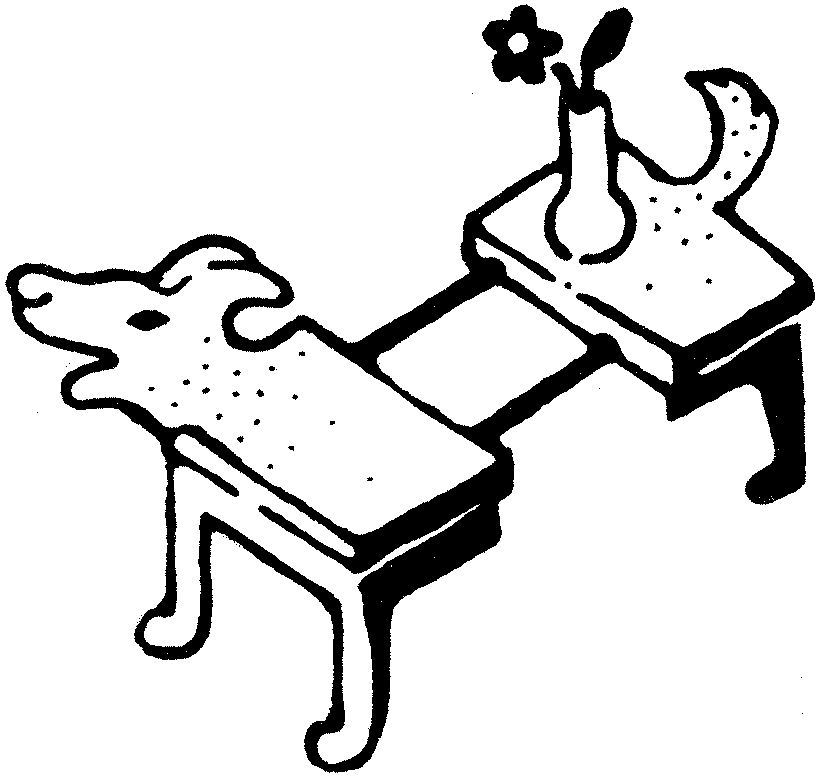Nothing special
An essay about how buying a table is impossible, and why we should all stop wanting to be “designers”.
Norma,
“A table, looking like what anyone might draw – four legs, one at each corner, straight and square and nothing unexpected.” That is caption number 26 to the “Less” table (Jean Nouvel, Unifor, 1994), part of the “Super Normal” exhibition curated in 2006 by Jasper Morrison and Naoto Fukasawa. 1
Leaving the Japanese aside for now, let us analyse that sentence – already so full of meaning. First of all, it seems to imply that a table must at least be “unexpected” to deserve being showcased in an art gallery. However, anyone could have designed this object with “nothing unexpected”: thus people involved in designing tables by profession must have the task of instilling surprise.
Instead this table – which is not extravagant, nor curved, nor a bark top set in glass supports 2 – is apparently vulgar, something no “designer” would want to associate with.
Design is expected to produce “new” or “beautiful” or “special” things. When we look around with this mentality, things outside of “design” are seen as “normal” or “ugly” in contrast. 3
“Designer” objects, at least in the Italian lexicon, are synonymous with unusual shapes. One imagines that anything that has not been perversely elaborated by a designer will perform poorly in sales, having nothing “attractive”, nothing that makes it unique compared to the competition. And if it is common belief that even a child could design a rectangular table with four legs on the sides, no company would ever want to attract such derision.
But children do not think in terms of “simplicity”: they challenge friends to design the most accessorised gadget, just like self-styled designers. Thus Milan’s Salone del Mobile is full of bells and whistles (or “frin-frin”) 4 and the homes of consumers who would like “just a table” are filled with postmodern sculptures. If you have ever tried to look for an object that is not “designer”, you will discover how the narcissistic selfishness of certain designers now pervades every area of design.
“Designer” trash bins with a Scandinavian touch, because garbage is placed on a pedestal now. 5
Meanwhile design, once an almost unknown profession, has become an important source of pollution. Encouraged by glittering “lifestyle” magazines and marketing departments, it has become a race to create the most eye-catching things possible through colours, shapes and surprises. 6
When the thrill of getting a “surprise” is commodified, ordinariness is at risk. Design is vulgarly interpreted as temporary entertainment, which however loses all value as soon as the show ends, when the initial emotion fades. And when everyone wants to be unique, everyone ends up being the same.

One might be tempted to belittle these considerations as yet another nostalgic surge, but ours is not generic criticism, and we make no mention here of a vague “today’s design”. This massive quest for uniqueness has precise roots in recent history, and its effects on the contemporary landscape are not accidental.
Libby Marrs’s impeccable analysis 7 retraces the last decade. We have all felt the anxious desire to invent completely original ideas, to distinguish ourselves from others, to do so through an occupation that is profitable but does not seem like some kind of soul-sucking “job”. 8
The social effects of this spasmodic search for professional independence are beside the point here, and were already well explored in a recent book by Silvio Lorusso. 9 We can focus instead on the consequent large-scale phenomenon, amplified by social networks’ initial wave of popularity, known as “Hipsterism”.
Hipsters are entirely characterised and centred around a fetish for authenticity. Echoing the Romantics, Hipsters pursue an ideal of concrete reality that insists on existing outside the globalised market and mainstream, mass consumerism. That is, its value derives from scarcity. 10
While having to respect constant references to past aesthetics, in which consumerism had not yet corroded the value of “handmade” objects, a continuous influx of new ideas and forms is required. In this increasingly complex search for authenticity, growing exposure on social networks has facilitated not only a rapid addiction to constant novelty, but also a widespread police state – enforced by designers ready to denounce plagiarism in front of anything that is not “unexpected”.
In satisfying the growing mainstream demand for non-standard products, or rather its illusion (under penalty of public derision on Twitter), Hipsterism has become a visual language in and of itself: scalable and infinitely replicable. The resulting “mass authenticity”, as defined by Libby Marrs, is a breaking point: a moment when the Hipster niche discovers it is global after all. The feeling behind it, however, is far from disappearing.

Design has made things special, and who wants a normal thing when you can have something special? 11 Too bad we figured out that the idyllic space built for special things outside of mass consumption is actually mass consumption itself.
Unable to see that the dream of authenticity is shattered, “post-authentic” designers are busy looking for new forms that will allow them to stand out. However, stripping ourselves of modernist prejudice, there is no difference between the current production of neo-Swiss extravagance, vaporwave dolphins on pink/aqua backgrounds, and Hipsters’ fake brush-stroke textures.
Whether it’s moustaches that are in fashion or abcdinamo sans-serif fonts, the attitude is the same: in a few years, we will see both with the same disgust, dreaming of who knows what other trend.
Because if the car we have in our life is dark grey, we wish to repaint it pink or lavender. But transformation means going without the car. And perhaps having a turtle instead. 12
So let’s reject “cars”, pro-modernist regurgitations and the search for originality. After all, special things are useless, and running for the latest novelty that attracts likes on Instagram is a mere waste of time. It is useless to escape from the flattening of taste: so accept the banality of the most obvious choice. After all, the truth is no one cares about which version of Helvetica was chosen for that canvas tote mock-up.

In the globalisation of preferences and events, the most “alternative” thing you can choose to do is reject the need to diversify. Nothing new: this is the conclusion drawn in the fourth paper published by K-HOLE in October 2013, 13 on the tail end of the Hipster parable.
This research, which opens with “It used to be possible to be special”, has been repeatedly cited first and foremost as the origin of the word “normcore”, a neologism blending “normal” and “hardcore”.
If Naoto Fukasawa used “super normal” to refer to something that already exists, something so ordinary or normal that anyone looking at it can say “it’s really normal!”, K-HOLE builds an entire subculture, which moves away from marking good taste through difference, embracing post-authenticity and seeking sharing and repetition. It is no longer just about an object, which people find “normal” while looking at it and expecting to be surprised: it is a broader search for freedom by people themselves.
“The details that distinguish you are so small that nobody can tell you’re actually different.” 14 If it’s difficult already for a designer to guess the exact version of Helvetica among hundreds of sans-serifs, how can the general public value the differences in quality between the almost artisanal serifs and the Times New Roman every single computer already has? Andrew Sloat wrote about it too, in a short paragraph, 15 but the issue has recently returned as a popular topic of discussion following the large number of Grotesk that are continuously churned out to satisfy a completely ephemeral market. 16
Indeed, “You’re so special nobody knows what you’re talking about”. 17 Designers’ profession, especially in the digital world, has been wrapped in so many layers of false complexity (aimed, somewhat understandably, at defending high budgets) that we feel obliged to label ourselves “UX specialists” or “brand strategists” not to feel left out. Good luck explaining to a customer that “UI/UX designer” is out of fashion and we are all calling ourselves “product designers” now. 18
In this case, we might think it enough to chase the cusp of the current trend to ensure that, if not at the most profitable point of the parable, we are at least in the one most sought after on Instagram. Unfortunately, “The markers of individuality are so plentiful and regenerate so quickly that it’s impossible to keep up”. 19 What is special, or “original”, changes as quickly as it is overexposed in the connected world.
By the time you consult a “design thinking” specialist, carefully choose a font an Écal student just created and no one has tried yet, follow all the latest mock-up dogmas to a T, you’ll finally publish a job that, after six months of work, is already six months old.
Enough then: let’s finally make tables that anyone could design – four legs, one at each corner, straight and square and nothing unexpected. Whether they are the same as all the others is irrelevant: taste would be flattened just the same, but there would be more useful items for sale.
Use Arial and Times New Roman in a single weight, black and white in columns of the same shocking banality that can be produced with Microsoft Word 97 without touching any settings. A4 pages, digital printing, low-res photos, and if the margins are blank that’s okay. Blue and underlined links, two lines of CSS, and no framework. Death to design. Non-graphics is profound liberation from everything that matters only to the public image of a “designer”.

As proof of the geographical and temporal diffusion of this sentiment, it is not only Naoto Fukasawa and Jasper Morrison who speak of “super normal” or K-HOLE of “normcore”. In 2003, Rob Giampietro 20 used the term “Default Systems” to describe those who want to remove designers from active participation by leveraging the fact that “This is how the computer works with minimal intervention”. Chiara Cesaretti, Sara Guazzarini and Irene Sgarro, in a research carried out in 2016 21 which explores precisely the conversation between Rudy VanderLans and Giampietro, speak of “automatic design” which – through solutions geared towards “do your job, don’t think too much, don’t fret over principles, don’t try anything out of the ordinary” – offers “a release from the breathless pace at which design now runs”, interested in all the possibilities that could have been used but which in fact have not been exploited. The theme was taken up again in 2020 by their teacher Silvia Sfligiotti in a critique of the modern contemporary under the title “This is auto-tune typography”. 22
However, even if many solutions seem to coincide with a modernist aesthetic – back in the spotlight since 2016-2017 thanks to many good, young Swiss people – the use of grids, typographic consistency, sobriety and palettes limited to greys or primary colours lack the ideological apparatus of “not wanting to do graphics”.
Because, above all, it is “a backlash against the kind of design tha creates things that to do not blend with people, with the environment and circumstances, or with lifestyles”. 23 In front of the degeneration of design into a marketing tool, to promote the identity of a corporation (or someone who would like to be one) and sell magazines, 24 the answer is to give up one’s role – just as the brutalist web made up of simple HTML pages was a reaction to the abuse of frameworks and useless parallax animations.
“In other words, Default Systems Design can voice the need for a new form of design that moves away from personal expression as a form of originality.” 25
Norma has applied and fine-tuned this idea, although in words it may seem so codified it cannot be easy to experiment, and seen how in reality it clashes with substantial distrust and a few formal dilemmas.
If projects by Experimental Jetset, famous in their own way (and the subject of the comments we mentioned by Giampietro and VanderLans 26), are accused of being “soulless”, imagine how hostile the reaction may be from an audience expecting some form of entertainment. The Dutch designer group’s reply is, “To say that a design is ‘soulless’ is the same thing as disliking a mirror for what you see in it. In the end, it’s not the design that is soulless, and it’s not the mirror that is having a bad hair day”. 27
Today, however, we don’t think the defence of “nothing special” needs to be justified in any way. Since the debate over contemporary design focuses solely on aesthetic issues and every decision is based on taste, for those who are unable to grasp ideology, we defend the aesthetics of giving up graphics as if it were any other aesthetic.
And given the unpopularity of these opinions, we can implicitly rule out the possibility that “non-graphics” can ever be so widespread it becomes repetitive and makes it impossible to identify individual organisations. Emphasising once again that, in any case, that identification is impossible because we are all basically the same, this remains a “normality” that “anyone” cannot do, because that anyone will always be busy doing what is polluting the landscape today.

However, K-HOLE is far-sighted in writing that “To be truly Normcore, you need to understand that there’s no such thing as normal.” 28 That “removing designers from the system” – as a reaction against those who wondered how designers could become authors – contains a paradox that is self-destructive at best.
Faced with the fact that graphic design students seem to be the most mass-produced object in the world, 29 the normality we propose here is comparable to firing the entire professional category. Looking above all at web design, normality is not the product of the recent “brutalist” trend: it’s WordPress. Almost 40% of the Internet is a site with a WordPress theme, and if we include the sites that use the platform only for their CMS, the figure is closer to 64%. 30 Ditto for graphics: the true face of normality is not the one sponsored on industry blogs, but what we find in flyers for dance classes, at village festivals and on pizza boxes.
The flight into individualism and the obsessive search for exclusivity are behaviours that belong to a past in which people were born in communities, and individuality was not so specific that it led to loneliness. Today, we are born as individuals, and it is our job to seek communities instead of attention. 31
Therefore, we cannot rule out that – once we will have freed ourselves from every preconception about what designers must do to be worthy of presenting themselves as designers, and from every personal expression and contemporary trend – there may be a further lesson in de-responsibility (to be interpreted more as wabi-sabi than à la Robert Venturi) to learn from the vernacular, where nothing is special.

-
1
“Super Normal”. Curated by Jasper Morrison and Naoto Fukasawa, Axis Gallery, Giappone, 2006. (jaspermorrison.com, naotofukasawa.com)
↩︎ -
2
Daniele Lago: “Tavolo Air”. LAGO Design, 2006. (lago.it)
↩︎ -
3
Naoto Fukasawa, Jasper Morrison, “Super Normal”, Lars Müller Publishers 2007, p.99.
↩︎ -
4
"frin-frin": a term used by Enzo Mari to define everything that is inconclusive and not worthy of attention. Michele Mari on an article by Cristina Moro: "Michele Mari talks about his father and designer Enzo Mari". Domus, April 2017. (domusweb.it)
↩︎ -
5
Bo Touch Bin: an elegant solution for waste collection. Brabantia. (brabantia.com)
↩︎ -
6
Jasper Morrison, see note 3.
↩︎ -
7
Libby Marrs: “Post-Authentic Sincerity”. 2020 (libbymarrs.net)
↩︎ -
8
Ibid.
↩︎ -
9
Silvio Lorusso: “Entreprecariat”. Krisis Publishing, 2018. (silviolorusso.com)
↩︎ -
10
Libby Marrs. Ibid.
↩︎ -
11
Ibid.
↩︎ -
12
Charlotte Joko Beck: “Niente di speciale”. Ubaldini Editore 1994, p.147.
↩︎ -
13
K-HOLE: “Youth Mode. A report on freedom”. October 2013. (khole.net)
↩︎ -
14
Ibid.
↩︎ -
15
Andrew Sloat: “Standard, Arial, Helvetica or Whatever”. Section of “7 Genders, 7 Typographies: Hacking the Binary”, by Riley Hooker. Walker, May 2016. (walkerart.com)
↩︎ -
16
@typographica: “Customers will find the samey grots elsewhere, often for free”. Twitter, December 2020. (twitter.com)
↩︎ -
17
K-HOLE. Ibid.
↩︎ -
18
Elizabeth Alli: “What UI/UX and Product Design is All About (and How to Learn It)”. Designerup, March 2020. (designerup.com)
↩︎ -
19
K-HOLE. Ibid.
↩︎ -
20
Rudy VanderLans, Rob Giampietro: “Default Systems in Graphic Design”. Emigre, 2003. (linedandunlined.com)
↩︎ -
21
Chiara Cesaretti, Sara Guazzarini, Irene Sgarro: “Retooling Modernism”. 2016. (irenesgarro.com)
↩︎ -
22
Silvia Sfligiotti: “This is auto-tune typography”. Medium, August 2020. (medium.com)
↩︎ -
23
Naoto Fukasawa. See note 3.
↩︎ -
24
Jasper Morrison. See note 3.
↩︎ -
25
Chiara Cesaretti, Sara Guazzarini, Irene Sgarro. Ibid.
↩︎ -
26
Rudy VanderLans, Rob Giampietro. Ibid.
↩︎ -
27
Experimental Jetset: “Statement and Counter-Statement”, Roma 2015, p.417.
↩︎ -
28
K-HOLE. Ibid.
↩︎ -
29
Enzo Mari.
↩︎ -
30
Brutalist Websites. (brutalistwebsites.com)
↩︎ -
31
Nick Galov: “35+ WordPress Statistics for the Budding Webmaster”. Hosting Tribunal. (hostingtribunal.com)
↩︎ -
32
K-HOLE. Ibid.
↩︎